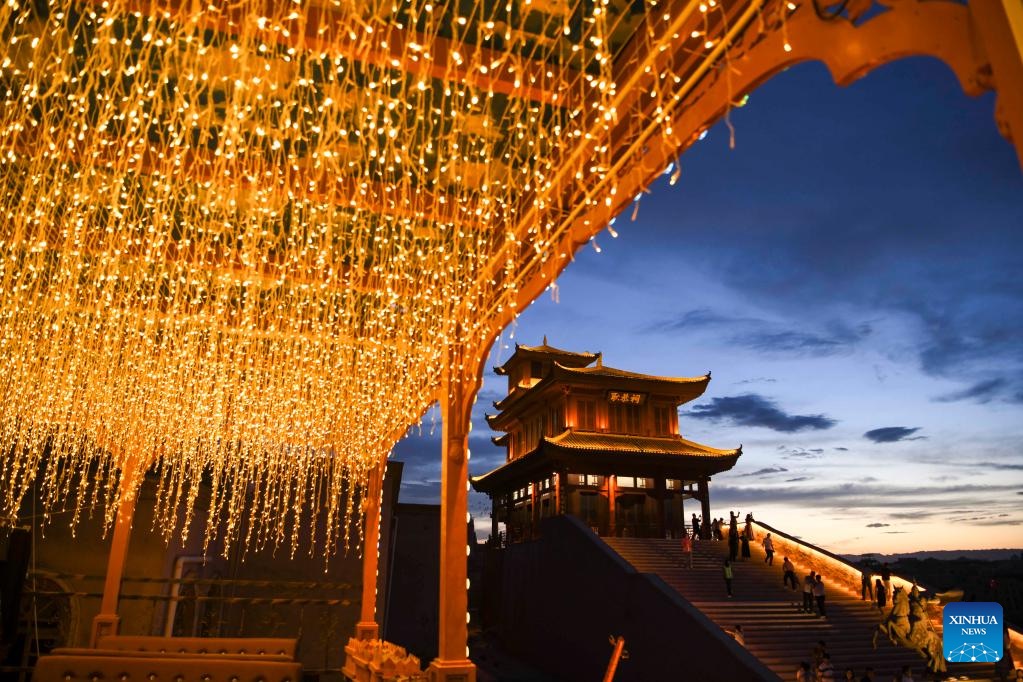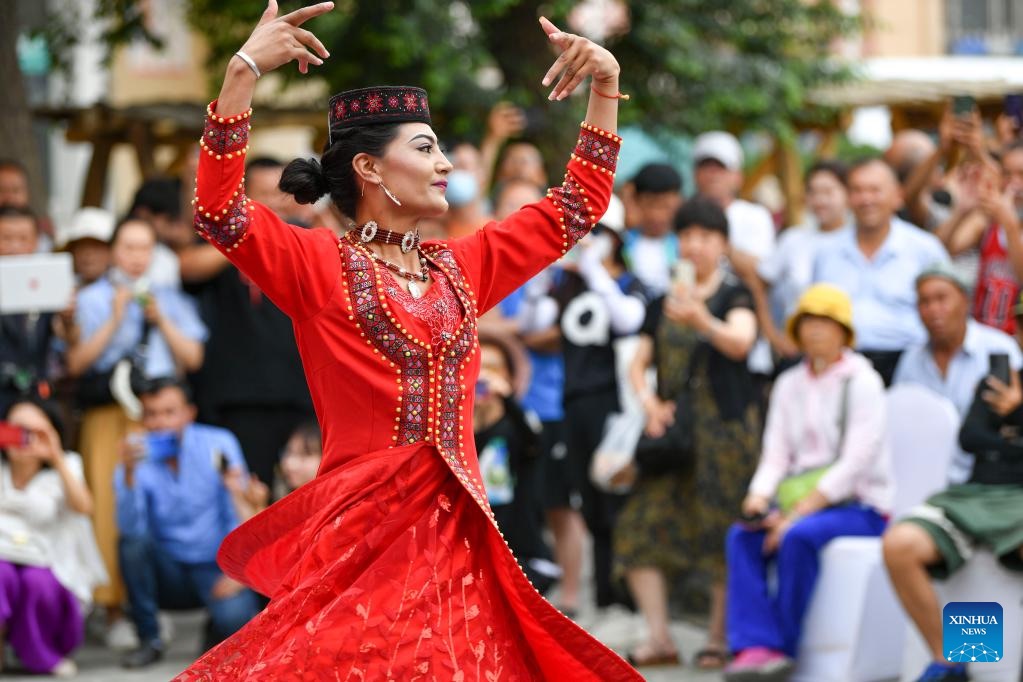Kashgar blends multi-ethnic culture, facilitates Eurasian commerce
From:XinhuaAuthor: 2023-06-25 11:00

Tourists visit the ancient city of Kashgar scenic area in Kashgar, northwest China's Xinjiang Uygur Autonomous Region, June 14, 2023. (Xinhua/Hu Huhu)
Ostangboyi, a teahouse nestled in the old town area of Kashgar City in northwest China's Xinjiang Uygur Autonomous Region, has become a beloved gathering place for neighbors, locals and merchants alike.
Here, amid the winding streets and ancient architecture, they can savor a cup of tea, engage in lively conversations and immerse themselves in the timeless beauty of their surroundings.
"With over a hundred years of history, the art of tea brewing may have evolved, but people's enduring passion for tea remains unwavering," said Memetkerim Memet, the teahouse's manager.
The rich heritage of Kashgar came alive as tea from south of the Yangtze River found its way to the western region of Xinjiang along the ancient Silk Road, integrating seamlessly into the lives of the locals.
In ancient times, Kashgar served as a vital transportation hub, connecting China with Central Asia and South Asia, said Xiao Xiaoyong, a professor at the Minzu University of China, adding that the confluence of diverse ethnic cultures in this region has given rise to a wealth of historical and cultural treasures.
Today, Kashgar has harnessed its cultural and geographical advantages, transforming into a unique tourist destination that blends history and modernity. Through favorable policies, improved infrastructure, and the promotion of cross-border exchanges, the city has also emerged as a catalyst for Eurasian commerce.
WHERE HISTORY MEETS MODERNITY
On the second-floor balcony of the teahouse, people joyfully sway to the enchanting melodies of the rawap, a stringed instrument, and the rhythmic beats of tambourines.
However, this place may not have always been as welcoming to tourists in the past.
"Houses in the old town were predominantly constructed using brick and wood structures. They lacked resilience against earthquakes and faced potential dangers, such as walls vulnerable to flood damage and limitations in fire rescue capabilities," said Memet Usman, father of Memetkerim Memet and the teahouse's former manager.
In 2010, a project was initiated with an investment of over 7 billion yuan (about 975 million U.S. dollars) to revamp the dilapidated houses. It involved a population of more than 200,000 people and an area of 8 square km in the old town. As a result, more than 7,000 traditional dwellings of historical and cultural significance were repaired and reinforced while preserving their original spatial patterns.
"The measures taken by the Chinese government to transform the old town of Kashgar are admirable," said Mohanad A.A. Alaklouk, permanent representative of Palestine to the Arab League, during his visit as a delegate of diplomats and officials from the Arab League and its Secretariat in May.
"This transformation has not only brought great changes to the residents' living environment and conditions, but more importantly, has preserved the local cultural characteristics," said Alaklouk.
Beyond the tangible architectural rejuvenation, Kashgar cherishes its intangible cultural heritage.
Zulpukar Ababakri is an inheritor of the Kashgar pottery tradition, which produces both household items and ornaments.
"For thousands of years, despite the evolution and innovation in earthenware techniques, the patterns of clouds, peaches, roses and grapes -- symbolizing fortune, good health and happiness in Chinese culture -- have remained intact and continue to captivate the multi-ethnic community of Kashgar," Zulpukar Ababakri said.
Kashgar not only celebrates its indigenous culture but also embraces the world with open arms.
Hadiya Msham Abulla, a student from Tanzania who studied medicine in China, is now married to her Uygur husband Dilshat Tursun. The couple started running a coffee shop in the old town of Kashgar this year.
Through live streams and online platforms, they share their stories and products with a global audience.
"The ancient city of Kashgar is a place of passion and fantasy. Despite living in a foreign land, I sense the feeling of home from the hospitable people," she said.
According to the Culture, Radio, Television, and Tourism Bureau of the Kashgar Prefecture, the region welcomed over 11 million tourists in the first five months of 2023, marking an 83.48 percent increase year on year, and resulting in tourism revenue of nearly 8.6 billion yuan, up 114.7 percent.
PASSAGE TO EURASIA
Earlier this month, 25 trucks loaded with containers departed from Kashgar. After arriving at the railway station of the city of Osh in Kyrgyzstan, containers were transferred onto trains bound for Tashkent, the capital of Uzbekistan.
It was a trial run for Kashgar to facilitate cross-border trade through the implementation of multimodal transport systems, ahead of the launch of the China-Kyrgyzstan-Uzbekistan railway.
"Kashgar is a passage connecting China to Central Asia, South Asia, West Asia, and even Europe. We are dedicated to providing support in streamlining customs clearance for foreign trade enterprises and ensuring the stability of industrial chains and supply chains," said Cao Hongjian of Kashgar Customs.
Kashgar has emerged as an attractive destination for enterprises seeking to capitalize on its key location. One such enterprise is Zhongshun E-commerce Co., Ltd., a foreign trade company established in Kashgar's comprehensive bonded zone in 2020.
"We collect goods from the Yangtze River Delta and Pearl River Delta and gather them in Kashgar, before dispatching them to Central Asia, Europe and other places. Presently, we process over 120,000 e-commerce orders daily," said Zhang Qi, the general manager of Zhongshun.
Ma Haitao, director of the zone's management committee, said that there are currently over 350 registered enterprises in the zone, including more than 280 trade and logistics companies and nearly 40 ones for manufacturing and processing.
In 2022, the value of cross-border e-commerce in the zone reached 1.29 billion yuan, up 291 percent year on year.
"With the development of cross-border e-commerce, general trade and processing trade with a longer value chain have also started to release their growth potential," said Ma.

An artist performs a show of intangible cultural heritage in the ancient city of Kashgar scenic area in Kashgar, northwest China's Xinjiang Uygur Autonomous Region, June 14, 2023. (Xinhua/Hu Huhu)

People spend their leisure time at a teahouse in the ancient city of Kashgar scenic area in Kashgar, northwest China's Xinjiang Uygur Autonomous Region, June 13, 2023. (Xinhua/Hu Huhu)

This photo shows tourists at the east gate of the ancient city of Kashgar scenic area in Kashgar, northwest China's Xinjiang Uygur Autonomous Region, June 14, 2023. (Xinhua/Hu Huhu)

This aerial photo shows a view of the ancient city of Kashgar, northwest China's Xinjiang Uygur Autonomous Region, March 10, 2023. (Xinhua/Li Xiang)
Edit:董丽娜
The copyright of the article and the picture belongs to the original author. If there is any infringement, please contact to delete it